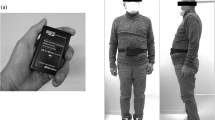Abstract
In subcortical vascular encephalopathy (SVE) gait disturbance is a common and early clinical sign which might be used to monitor disease progression. In the absence of reliable scales and with regard to the equivocal results of highly complex gait imaging devices we assessed the natural course of SVE in a prospective study, using a new straight forward technique to quantify and compare sequential gait studies. We report the results of 300 computerized gait analyses in 119 patients with SVE and 63 age-matched controls. Thirty-nine SVE patients were re-evaluated to monitor the natural course of the disease and to study the correlation of gait disturbances with MRI changes and neuropsychological findings. The system consists of a set of shoes containing 16 load sensors and a measuring-unit reading each sensor at 20-ms intervals. By off-line analysis we graded each recording on a Gait Disorder Score (GDS) with six variables indicating gait steadiness: step frequency, length of gait lines (which represent the movement of the centre of gravity during heel to toe movement), length of single support lines, variability of single and of double support lines, and double support time. In cross-sectional analysis, patients with SVE showed cadence (steps/min) to be reduced at 87.3±19.5 (96.4±7.8 in controls, P < 0.05). Length of gait lines was significantly less: 0.70±0.13 vs. 0.80±0.05 in controls, with length of single support gait lines reduced at 0.42±0.14 in SVE (0.58±0.06 in controls, P < 0.05). Variability of both single support lines (5.69±1.90%; 4.24±1.07% in controls, P < 0.05) and double support lines was elevated (3.59±1.62% vs. 2.54±0.59%), while duration of double support phases was increased (0.19±0.10 s vs. 0.13±0.02 s in controls, P < 0.05). The progressive character of the disease was demonstrated by increasing GDS values in 39 SVE patients with a frontal gait disorder who were re-investigated after a mean interval of 26 months (5.4±4.5 vs. 8.4±5.5, P < 0.05). This study shows the value of a new and practicable gait analysis system for the evaluation of gait disorders and it quantifies the deterioration of gait in SVE patients.
Similar content being viewed by others
Author information
Authors and Affiliations
Additional information
Received: 6 September 1999 / Received in revised form: 25 April 2000 / Accepted: 28 May 2000
Rights and permissions
About this article
Cite this article
Bäzner, H., Oster, M., Daffertshofer, M. et al. Assessment of gait in subcortical vascular encephalopathy by computerized analysis: a cross-sectional and longitudinal study. J Neurol 247, 841–849 (2000). https://doi.org/10.1007/s004150070070
Issue Date:
DOI: https://doi.org/10.1007/s004150070070




